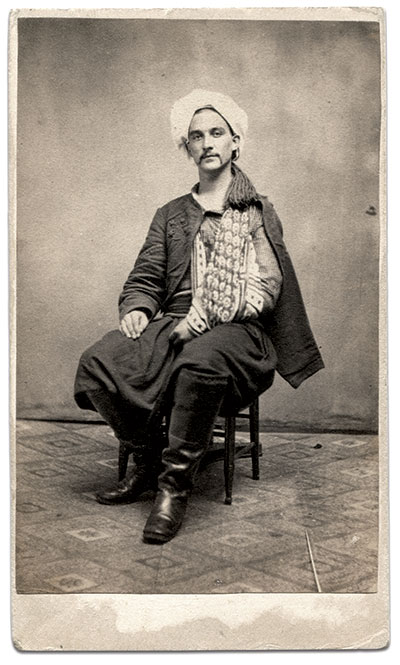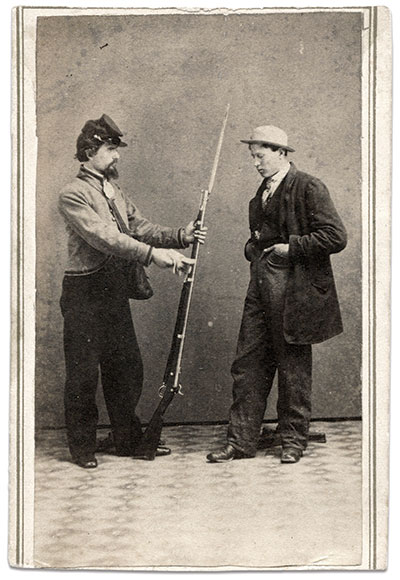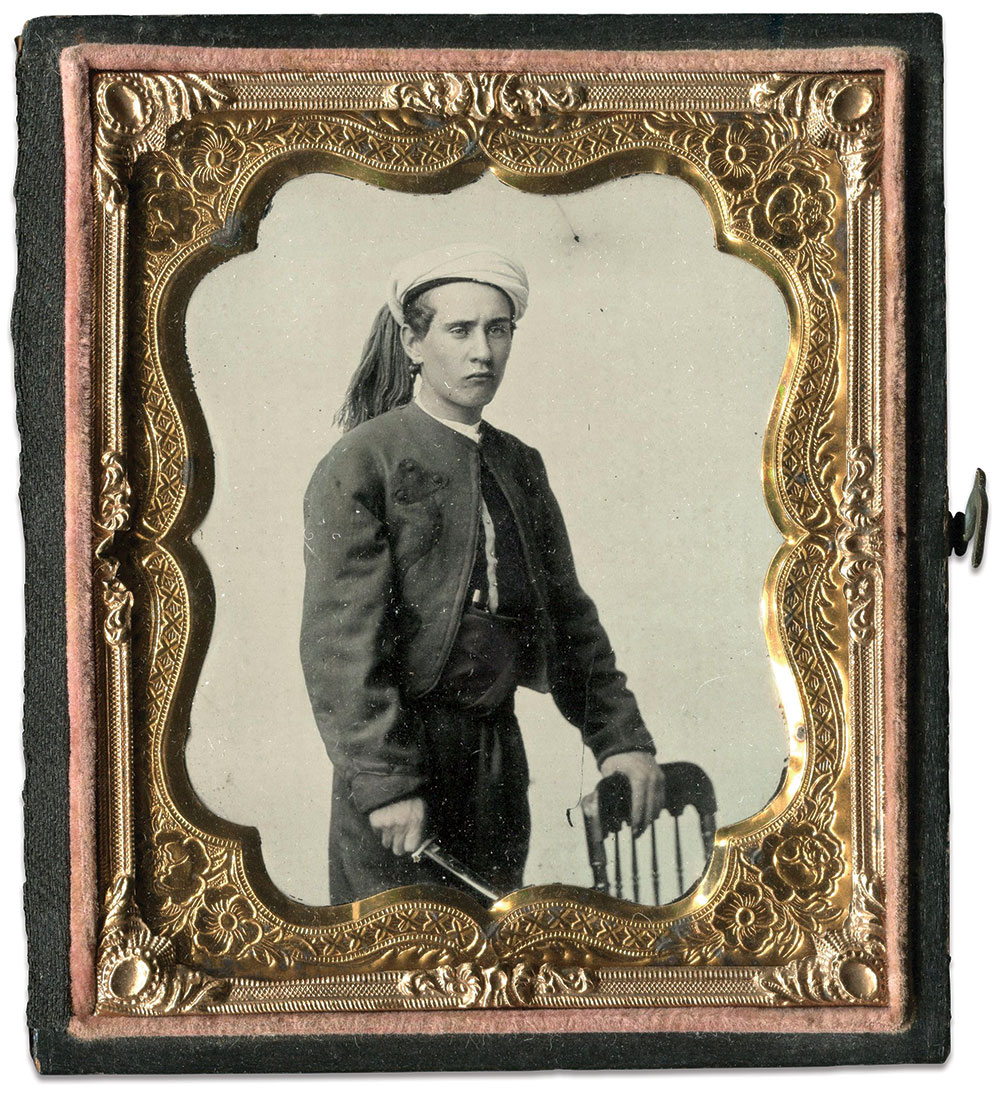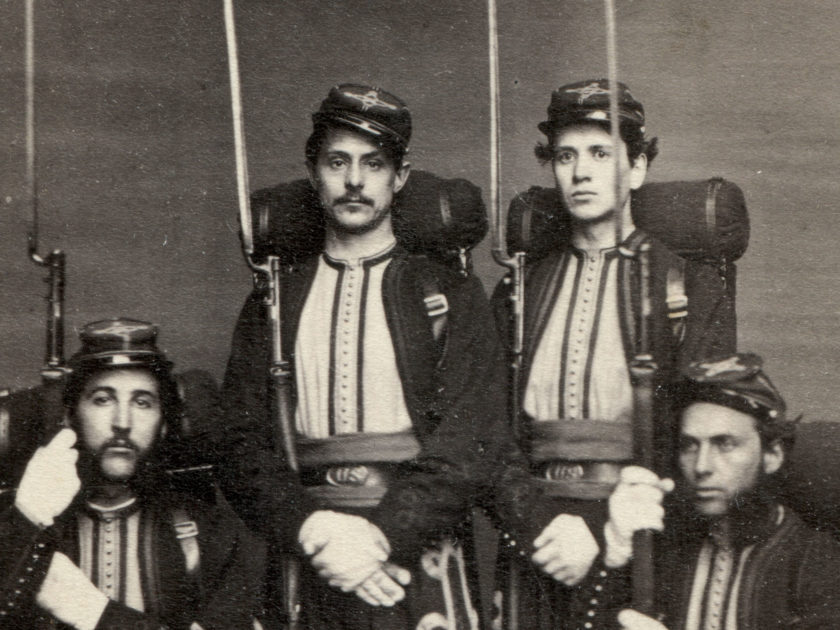Zouave fashion erupted into a full-blown phenomenon during the Civil War as citizen soldiers on both sides of the conflict joined the volunteer armies. Individual organizations adopted a signature style in which the membership dressed accordingly. The Zouave movement marched on in natty glory until the 1890s. By that point, the militia system that had dominated the American military scene for decades had morphed into the National Guard. As uniform styles evolved to meet the practical tactical necessities on the ground, the Zouave fashion became obsolete. Though the representative portraits pictured here are far from a complete picture of the American Zouave, the images are a tribute to its far-reaching influence.
Dan Miller has amassed a sizable and diverse collection of Zouave images over many years. The collection is at the center of his forthcoming book that traces the culture and uniforms of the Zouave soldier in America.

13th New York State Militia
The distinctive red trimmings, short rollover collar and white waist belt with flat brass belt plate marks this soldier as a member of Company D of the 13th New York State Militia. The regiment was activated in 1861 for duty in Annapolis and Baltimore, Md., in 1862 in southeastern Virginia, and in 1863 during the Confederate invasion that ended in the Battle of Gettysburg.

Elder Zouaves
The mourning badge worn by this soldier pays tribute to Elmer E. Ellsworth, who had a tremendous influence on Zouave culture before his untimely murder in May 1861. The unidentified man wears a fatigue blouse and dark trousers typical of early Michigan regiments. He is believed to have been a member of the Elder Zouaves of Lansing, Mich. The company was named for its commander, Capt. Matthew Elder. This band of Zouaves joined the 8th Michigan Infantry as Company E, which matches the company letter attached to his cap.
Duryée’s Zouaves

Cpl. Joseph Hughes (1844-1907) of Company F, 2nd Battalion, 165th New York Infantry (Duryée’s Zouaves). Hughes was wounded in the left forearm by a musket ball during the Battle of Port Hudson, La., on May 27, 1863. This image was probably taken while on convalescent leave. The disheveled turban suggests that his wound made it difficult to tie. Less than a year later, during the Battle of Sabine Cross Roads, La., on April 8, 1864, Hughes was wounded again in the left hand and foot. Of note is the trefoil, or tombeau, visible on his jacket. Composed of braid that puckered when the trefoil was formed, three cloth-covered buttons were attached to give it a more uniform appearance.
Burnside Zouaves

In June 1861, a company of Rhode Island home guards was organized in Providence. Known as the Burnside Zouaves in honor of Gen. Ambrose Burnside, its membership included Sgt. Augustus Wright. The company joined the state’s 1st National Guard and largely served in Rhode Island, with the exception of a three-month tour on federal duty in the defenses of Washington, D.C. Wright, however, did not make the trip to the nation’s capital. He is pictured here with a half-moon insignia displayed on his vest. The guardsmen likely adopted the insignia to signify their company membership when out of uniform.

Reminiscent of Ellsworth’s Cadets
Not all variations of Zouave uniforms can be identified to a specific company or regiment. Such is the case here. The uniform worn by this musket-wielding soldier resembles that of the original company of Ellsworth’s Zouave Cadets of Chicago. The characteristic that sets it apart from the Ellsworth uniform is the cuffs—they are encircled by wide bands of lace and topped by three or four upward slanting strips and buttons.
Less Ostentatious Western Zouave

The Union army’s 13th Corps, which served primarily in the war’s western theater, had its share of Zouave-inspired regiments. They wore uniforms that were generally less ostentatious than their counterparts in the East. Such is the case with this unidentified cavalryman. This style of light-trimmed jacket is unusual for mounted troops, though fairly common to infantrymen.
Albany Zouave Cadets, 10th New York State Militia

Lucien Barnes, a private in the Albany Zouave Cadets, poses with his Model 1855 rifle musket and equipment. His numbered knapsack indicates his service in the 10th New York State Militia, to which regiment the company served with the exception of a nine-month stint in 1862-1863, when it was activated for federal service. Though Barnes did not answer the call for federal duty, he remained in uniform throughout the war and the postwar years. He left the company as a lieutenant in 1870, and lived until 1910. He is pictured here about 1862. His distinctive cap features a New York state shield, a pompon and piping that circles the crown and band.
2nd Massachusetts Battery of Light Artillery

This Massachusetts soldier removed his greatcoat to reveal his attractive uniform replete with distinctive trim and fringed shoulder scales. He served in the 2nd Massachusetts Battery of Light Artillery, also known as Nims’ Battery after its original captain and commander, Ormand F. Nims. The battery would perform good service primarily in Louisiana and Mississippi during the war, but without these uniforms. The salt air obliterated the color in the fabric before they left the Bay State, and the uniforms were replaced with those of regulation blue.
Chicago Light Infantry

The uniform worn by this soldier is believed to be the same style adopted by the Chicago Light Infantry, the first company formed in Chicago after the bombardment of Fort Sumter. Of note are the light blue trousers adorned with a large modified Austrian knot, and an oval belt plate festooned with what appears to be an outstretched eagle and 13 stars. The company was mustered into federal service as Company D of the 19th Illinois Volunteer Infantry. The regiment served for three years and participated in numerous engagements, including the Battles of Stones River, Tenn., and Chickamauga, Ga.
Springfield Zouaves, or Governor’s Guard

A group of soldiers in the Springfield Zouaves, commonly known as the Governor’s Guard, posed with all the trappings of campaign. Though the men give every appearance of a wartime outfit, their company was organized after the war. They wore elaborate uniforms of dark blue with prominent Austrian knots on their voluminous trousers, and caps emblazoned with a quatrefoil design. Reports of company doings appeared in local newspapers as late as 1887.

Racine Zouave Cadets, Wisconsin State Militia
These young men belong to the Racine Zouave Cadets, one of the companies that served in the Wisconsin State Militia from 1862 to 1864. Seated in the front row are 2nd Lt. Winfield Scott Tefft, Capt. Frederick Ullman Jr., and 1st Lt. Louis A. Cowell, Standing behind them are Sgt. Francis Richard “Frank” Kelley and Pvt. Horace Knapp. Man’s best friend lying on the floor was not identified. Ullman and Tefft later served in Company C of the 1st Wisconsin Heavy Artillery.
14th New York Infantry

Clad in a fez, canvas gaiters and a nondescript pull over shirt with no indication of rank, Capt. John J. Babcock of the 14th New York Infantry, posed for this portrait about June 1861. He commanded Company G, which was originally formed as the Gansevoort Light Guard in Rome, N.Y. Babcock’s tenure as captain ended less than a year later when he resigned in May 1862. At the time, the 14th was engaged in the Peninsula Campaign. The 14th suffered heavy casualties less than two months later at the Battle of Malvern Hill, and would go on to fight at Fredericksburg before it mustered out of federal service in May 1863.
Ohio Militia and the Essence of Volunteerism

The essence of volunteerism in the Union army is captured in this portrait of a Zouave, who offers a bundle of greenbacks and a rifle to a skeptical recruit. The jacket generally matches the grey Zouave uniform authorized for the Ohio Militia of the Reserve in 1861. But the dark cap and trousers are not consistent with the official description.

Collis’ Zouaves of Pennsylvania
The turban and uniform worn by this soldier indicates his service in Collis’ Zouaves, an independent company raised in Philadelphia by Irish-American Capt. Charles H.T. Collis. Also known as the Zouaves d‘Afrique or Crimean Zouaves, it served as the bodyguard to Maj. Gen. Nathaniel P. Banks. Collis would go on to recruit an entire regiment of Zouaves that mustered for federal service as the 114th Pennsylvania Infantry.
Successors to Ellsworth’s Original United States Zouave Cadets

The large sun shaped pattern and long peaked cuffs on the jacket worn by this Zouave are hallmarks of the first style uniform worn by the Ellsworth Light Infantry. The membership of this company, organized on April 2, 1861, considered themselves the successors to Elmer E. Ellsworth’s original company of United States Zouave Cadets. The organization was also known as the Ellsworth Zouaves Company F and the 6th Company of Chicago Zouaves. This soldier sports a 12-pointed star attached to his vest. The initials J.B.R. inscribed on the back may be a clue to his identity.

Piatt’s Zouaves
An enlisted man with his musket wears the distinctive gray felt hat bound with red tape and trousers with double red stripes of Piatt’s Zouaves. Named for colonel and commander Abram Sanders Piatt, the regiment was also known as the 1st Regiment of Zouaves and mustered in for federal service as the 34th Ohio Infantry. Piatt’s Zouaves served primarily in West Virginia and the Shenandoah Valley during its enlistment.

National Zouaves
The National Zouaves, or 10th New York Infantry, was attired in a variety of uniforms during its four-year enlistment. This young man, likely a resident of Brooklyn where the regiment was recruited, is attired in what appears the third pattern uniform. It features a tombeau made from cut cloth and cloth buttons. He grasps a Bowie knife and carries a fife tucked into his sash. The National Zouaves participated in numerous battles during the war, including Second Bull Run, Fredericksburg and The Wilderness.

Keystone Zouaves
The men of the Keystone Zouaves, or 76th Pennsylvania Infantry, sported at least three different uniforms during their four-year enlistment. This unnamed soldier from the regiment wears what appears to be the second variation, which features a dark jacket, likely blue, with wide facings. The uniform was worn in early 1862, during which time the 76th was involved in operations along the South Carolina coast at Hilton Head and James Islands.

New York State Zouave
The SNY waist belt buckle and uniform indicates that this soldier served in a New York State Zouave company, though the identity of the organization is not known. He wears a unique jacket sans tombeau designs and buttons on one edge of the jacket without corresponding buttonholes on the opposite side. He is armed with an ultra-rare Model 1847 Sappers and Miners musketoon, or short-barreled musket, with an enormous roman short sword bayonet. Also visible is a tripod with a neck clamp, used to keep the soldier steady during exposure times. The image was discovered in Westchester County, N.Y.
SPREAD THE WORD: We encourage you to share this story on social media and elsewhere to educate and raise awareness. If you wish to use any image on this page for another purpose, please request permission.
LEARN MORE about Military Images, America’s only magazine dedicated to showcasing, interpreting and preserving Civil War portrait photography.
VISIT OUR STORE to subscribe, renew a subscription, and more.

